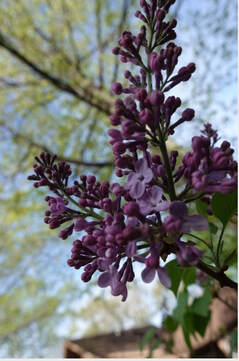|
Enjoy the fragrance and beauty that lilacs bring in spring. Today with about 30 different species, varieties have been developed for heat tolerance, reblooming flowers, compact size and even growing happily in a container on a balcony.
Clusters of small, four-lobed flowers are developed into cone-shaped to narrow pyramid clusters (panicles, i.e., branched inflorescence) that stand out from the green heart-shaped leaves. These flowers can be single or double in every imaginable shade of lilac and purple to hues of red, pink, blue, yellow, cream and white—even picotee (white-edged, deep purple ‘Sensation’). Its color may also change from bud to bloom as the flower matures. Lilacs grow best in full sun, with good drainage and fertile, slightly alkaline soil. Begin with testing soil drainage by digging a hole 8 inches across and 12 inches deep and filling it with water. If any water remains in the hole after an hour, choose another planting area. After following the planting directions on the tree’s label, water lilacs regularly for the first couple of years—at least 1” of water a week. Ongoing maintenance: Cut off spent flower-heads within a month after bloom to help set more flowers for next year. Cut off root suckers to keep the common lilac from spreading into a colony. Prune out any dead or broken branches from storm or winter damage. Pruning annually is not necessary, but to rejuvenate an overgrown plant or one that blooms sparsely, cut 1/3 of the oldest branches back to 12-15” from the ground. Do this over a 3-year period to refresh the plant without sacrificing blooms. Powdery mildew can be unsightly but generally does not harm the plant. You can make a spray of 2 tablespoons of baking soda in a gallon of water with a couple of drops of Ivory liquid. Spray it on the leaves, but not if the temperature is over 80°. The alkalinity of the solution helps to kill the fungus. Early Spring maintenance: Apply granular organic fertilizer at the base of the plant and water it in well. Buds are set the previous year, so the fertilizer feeds this year’s leaves and next year’s blooms. Fall maintenance: If your soil is very acidic, add garden lime. Rake fallen leaves from around the plant, and if you had powdery mildew or any disease, bag leaves and toss in the garbage. Did you know, the stems of the common lilac have a spongy pith that can be removed, leaving hollow tubes that were used to make pan-pipes? In 1753, Carl Linnaeus first described the lilac genus, Syringa, from the ancient Greek word syrinx, meaning pipe or tube. Credit to https://ngb.org/year-of-the-lilac/ Contributed by: Vicki Gee-Treft, Master Gardener Volunteer
0 Comments
Leave a Reply. |
|
| North Country MGV | gARDEN bLOGS |
Location |
|

 RSS Feed
RSS Feed